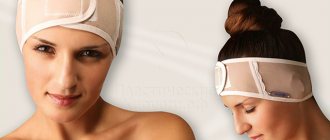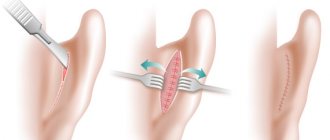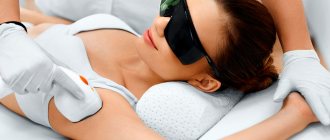Aesthetic indications for ear surgery are mostly limited to the correction of protruding ears (protruding ears). Its causes include: underdevelopment of the helix and antihelix, hypertrophy of the cup, protrusion of the earlobe, as well as a combination of the above options.
Accurate diagnosis of existing problems and discussion with the patient are the basis for quality treatment.
Correction of protruding ears can be performed at any age, however, if done at the age of 5-6 years, this relieves the child of a complex that is often fueled by other children at school. The optimal situation is when your child begins to ask questions about his ears and would like them to become the same as those of most children. Then going to the surgeon is easy for you and for him.
By 5-6 years, the auricle is fully formed and has grown to 85% of its final size; the cartilage is softly elastic and easily takes the desired shape during surgery.
Progress of the operation
There are several techniques for performing otoplasty. They can be divided into three groups.
The first group of operations (suture) to correct the auricle uses sutures on the cartilage.
The second group of operations (resection) involves removing sections of cartilage and then stitching them together.
The third group is a combination of suture and resection techniques.
The choice of surgical technique to correct protruding ears depends on the correct preoperative analysis.
Auricular plastic surgery is performed on an outpatient basis and does not require hospitalization. The operation is performed under local anesthesia and usually lasts about an hour, sometimes a little longer.
The surgical field is treated and covered with sterile surgical linen. A skin incision up to 4 cm long is made behind the auricle. After hemostasis, the cartilage is modeled with incisions and sutures.
Sutures are applied with non-absorbable threads in such a way as to form the correct shape of the auricle and get rid of protruding ears.
The skin incision behind the ear is often sutured with threads that dissolve on their own.
How to fix a deformed earlobe?
What not to do:
Many people believe that in the presence of the complication in question, local ear plastic surgery will help correct the situation. This opinion is wrong. Even if the operation is performed flawlessly, the correction will only give a short-term effect, since it will not eliminate the main cause of the problem. Moreover, the situation may be aggravated by the lack of free dermis in the area of the auricle, as well as the need for additional excision. This fact increases the risk of additional stretching of the lobe.
Correct tactics:
In this situation, in my opinion, there is only one correct solution. You need to do a facelift again. All this implies a change in the tension vector, the correct choice of skin layout, as well as correction of fixation. Thus, the earlobe will not act as the main object of correction. Its shape will be restored due to the correct application and degree of tension of the skin flap on the front part.
When performing the operation according to the above scheme, I always manage to solve the problem of deformation of the auricle. Moreover, I eliminate visible scars and scars located on the lobe. You can see this in more detail in the presented photograph.
Patients often experience a pronounced change in the shape of the ear tragus. This phenomenon occurs due to improper distribution of external and internal load on soft tissues. In this situation, the selection of a surgical tightening method is important. I discussed this topic in more detail in my original article “invisible seam”.
After otoplasty
In the operating room, a bandage is placed on the patient's head, which will be removed with a dressing the next day.
As a rule, during the day the patient is allowed to walk without a bandage, of course protecting the ears from accidental injury, but at night we recommend wearing a bandage in the form of a cap (a very ordinary cap, similar to those worn by small children), which is tied on the chin. The point of the bandage is not to press down on the ears, but to prevent them from being injured during sleep. You should sleep in this cap for up to 8 weeks. During this time, the shape of the auricle begins to be maintained not by sutures, but by internal scars.
In the first days after surgery, you will experience moderate pain, which is reduced with the help of painkillers.
After otoplasty, the ear area may feel numb and swollen, and there is usually bleeding in the surgical area.
Bruising and swelling usually completely resolve within two weeks after otoplasty.
Hair can usually be washed on the 2nd day.
Usually, sutures after otoplasty do not need to be removed, since the wounds are sutured with threads that dissolve on their own.
Most patients return to work the very next day after surgery. For 8 weeks, you cannot engage in contact sports (wrestling, basketball) to avoid accidental injury.
Children can return to school in a week.
“ELF LOPE”, deformation changes in the ear – determining the root cause
In a number of situations, after a certain period of time after surgery, many patients experience severe deformation of the earlobes. They begin to stretch downwards.
An example of correction of ear deformation two weeks after the repeated procedure
It is worth mentioning that even some practicing plastic surgeons are not always able to identify the true cause of such changes.
I must say that this phenomenon occurs due to an incorrectly selected direction of tension of the skin tissue and subsequent incorrect layout. The presented photograph shows that during the tightening, the doctor did not quite correctly determine the vector of skin tension. The result of this was that the skin flap was not sewn in the way it was necessary. Subsequently, he began to pull his earlobe down, subsequently it stretched, sagged and gradually acquired a shape reminiscent of an “elven”.
Another reason for deformation is excessive excision of the epidermal layer. This rather gross surgical error is quite rare, but often leads to the formation of strong surface tension and overstretching of the skin.
Risks and complications of otoplasty
Auricular plastic surgery is performed for aesthetic reasons, so the most common problem is the lack of the planned result. This may arise as a result of technical errors, incorrectly chosen surgical technique, accidental injury received by the patient in the postoperative period, but also insufficient mutual understanding between the surgeon and the patient when planning the outcome of the operation.
A slight degree of asymmetry in the size, shape and location of the auricle is the norm, however, patients, especially with a pronounced degree of protruding ears, sometimes begin to suffer from perfectionism - the search for perfection in an imperfect world. Before surgery, you should clearly understand that absolute symmetry is desirable, but not always achievable.
Suppuration of the surgical wound after otoplasty is very rare.
If the temperature rises to high levels, severe swelling occurs, or intense pain appears in the wound area, you should immediately contact the clinic; this may be inflammation.
Another complication of ear surgery may be the formation of a hematoma. To treat a hematoma, you need to remove the skin sutures, remove the accumulation of blood and stop the bleeding from the vessel. Postoperative bleeding does not have a negative impact on the outcome of otoplasty. The risk of bleeding after otoplasty is greater if the patient took aspirin before surgery.
Ears (otoplasty)
Are there any contraindications to otoplasty?
Like any surgical intervention, in addition to its indications, it also has its contraindications.
Here are the main ones: • blood clotting disorders; • infectious diseases; • exacerbation of any chronic diseases; • inflammatory diseases of the ear, nasal cavity and throat; • existing inflammatory elements located next to the auricle; • diabetes; • menstruation; • pregnancy; • oncological diseases; • immunodeficiency states.
How should you prepare for surgery?
Before ear surgery, a standard examination is required, as before any surgical procedure. It should include blood tests (general, HIV, RW, hepatitis B, C), determination of blood clotting time. A standard examination is also carried out, including fluorography and ECG.
Two weeks before ear surgery, the doctor will recommend that you stop taking medications that may affect blood clotting.
These drugs include those that contain acetylsalicylic acid. For example, such drugs include aspirin, sedalgin, antigrippin, askofen, citramon, coficil and others. If for any indication you need to take these medications, you should stop taking them 2 weeks before surgery.
Smokers are advised to reduce the number of cigarettes they smoke before and after surgery (or at least significantly reduce the number of cigarettes they smoke). You should also avoid drinking alcohol at this time (this also applies to the postoperative period). The operation is performed under local anesthesia, so there is no need to refuse food; it is possible to take a light breakfast before the operation.
But otoplasty also has its own characteristics of the preparatory period. In particular, measurements are taken of the ears and photographs are taken of them. A consultation with a surgeon is also mandatory. During it, together with the doctor, all issues related to the current situation are discussed, as well as what can be obtained as a result of plastic surgery. It is necessary to tell the doctor about all previous cases of allergic reactions to medications.
How long does the operation last?
The operation to perform ear plastic surgery lasts about 2 hours. Moreover, after it is carried out, as a rule, there is no need to stay in the hospital. In most cases, otoplasty is performed on an outpatient basis; after this operation, the patient can go home. In this case, it is mandatory to follow all the doctor’s recommendations.
What complications can occur after otoplasty?
Plastic surgery on the ears is practically not accompanied by complications, but it should be said that they cannot be completely excluded. As a rule, the percentage of various complications does not exceed 0.5% (this corresponds to approximately one case for every 200 operations performed).
A complication after surgery may be persistent pain. The reason for them may be different. For example, pain may be associated with a bandage that is too tight, which is recommended to be worn in the first days after surgery. The cause of pain may also be an inflammatory process that has developed at the site of the operation. In this case, as a rule, there is an increase in temperature. In such a situation, you need to immediately consult a doctor. Treatment in this case may consist of prescribing antibacterial agents.
When is the best time to have otoplasty?
Growth and changes in the auricle occur almost throughout life, but the greatest changes occur during childhood. For example, by the age of 6, the size of the auricle already reaches 85% of its size in adulthood. By the age of 9 this figure is 90%, and by 15 - 95%.
Taking this into account, ear plastic surgery can be performed starting from the age of eight. This period is successful not only because by this age the auricle is practically already formed. It is also important that undergoing otoplasty at the age of 8 will allow the child to avoid possible psychological trauma at school, which can seriously affect his psyche. All this concerns the timing of aesthetic ear surgery. Reconstructive operations on the ears can be performed at any time when the need arises.
Many people also wonder about the best time of year to carry out this operation. It should be borne in mind here that in the postoperative period you will need to wear a bandage, which may not always be comfortable on hot summer days. Taking this into account, the best time to perform otoplasty can be called the autumn-winter period. But this recommendation is not mandatory; ear surgery can be performed at any time of the year.
Risk percentage
After an operation such as otoplasty, scars can be pronounced and noticeable in case of complications, infection, suppuration, suture dehiscence and re-application, and an individual tendency to form keloid scars.
International statistics say: the percentage of consequences is negligible - from 3 to 4% in different countries of the total number of those operated on. To avoid getting into this situation, inform your doctor about the presence of diabetes mellitus, a tendency to form keloid scars in previous operations, in close relatives, and exacerbation of chronic diseases.
Deformation after a lift: avoiding complications
During surgery, it is extremely important that the surgeon correctly determines the strength and direction in which the skin flaps will be tensioned. That is, a visible rejuvenation effect should appear, but it is important to prevent undesirable consequences in the form of deformation of the earlobe that occurs from excessive stretching of the skin.
I explain to every patient who comes to see me the complexity and painstaking work of a plastic surgeon. At the same time, I always emphasize that this work requires a lot of practical experience, the desire to constantly improve one’s skills and abilities, and a sincere desire to help people become better.
You can read more about Dr. Kudinova here.









